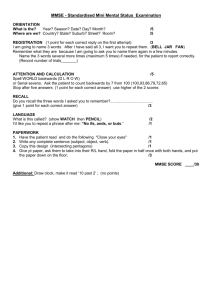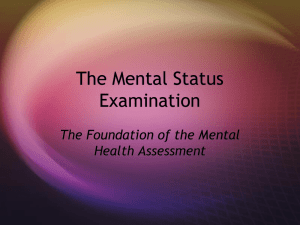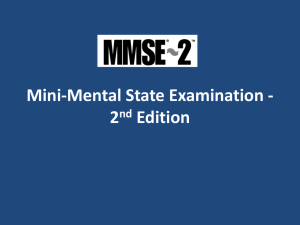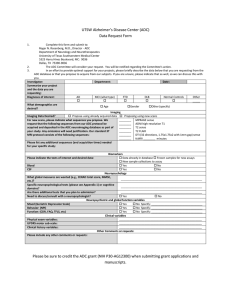Correlates of Level and Change in the Mini-Mental State Examination
advertisement
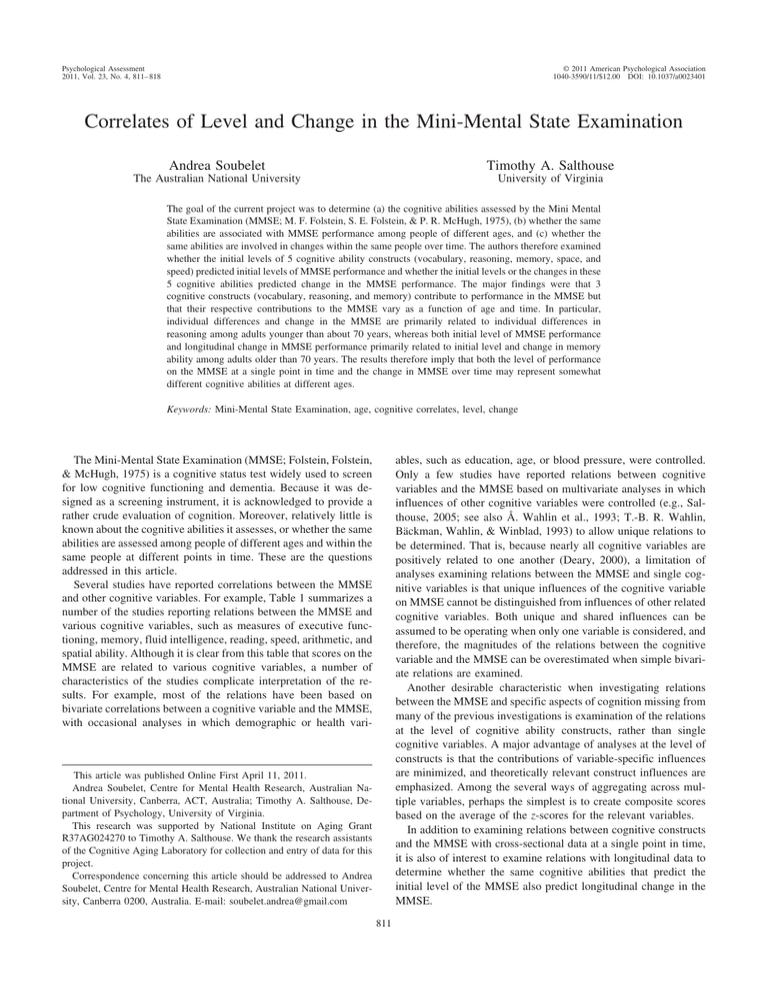
Psychological Assessment 2011, Vol. 23, No. 4, 811– 818 © 2011 American Psychological Association 1040-3590/11/$12.00 DOI: 10.1037/a0023401 Correlates of Level and Change in the Mini-Mental State Examination Andrea Soubelet Timothy A. Salthouse The Australian National University University of Virginia The goal of the current project was to determine (a) the cognitive abilities assessed by the Mini Mental State Examination (MMSE; M. F. Folstein, S. E. Folstein, & P. R. McHugh, 1975), (b) whether the same abilities are associated with MMSE performance among people of different ages, and (c) whether the same abilities are involved in changes within the same people over time. The authors therefore examined whether the initial levels of 5 cognitive ability constructs (vocabulary, reasoning, memory, space, and speed) predicted initial levels of MMSE performance and whether the initial levels or the changes in these 5 cognitive abilities predicted change in the MMSE performance. The major findings were that 3 cognitive constructs (vocabulary, reasoning, and memory) contribute to performance in the MMSE but that their respective contributions to the MMSE vary as a function of age and time. In particular, individual differences and change in the MMSE are primarily related to individual differences in reasoning among adults younger than about 70 years, whereas both initial level of MMSE performance and longitudinal change in MMSE performance primarily related to initial level and change in memory ability among adults older than 70 years. The results therefore imply that both the level of performance on the MMSE at a single point in time and the change in MMSE over time may represent somewhat different cognitive abilities at different ages. Keywords: Mini-Mental State Examination, age, cognitive correlates, level, change ables, such as education, age, or blood pressure, were controlled. Only a few studies have reported relations between cognitive variables and the MMSE based on multivariate analyses in which influences of other cognitive variables were controlled (e.g., Salthouse, 2005; see also Å. Wahlin et al., 1993; T.-B. R. Wahlin, Bäckman, Wahlin, & Winblad, 1993) to allow unique relations to be determined. That is, because nearly all cognitive variables are positively related to one another (Deary, 2000), a limitation of analyses examining relations between the MMSE and single cognitive variables is that unique influences of the cognitive variable on MMSE cannot be distinguished from influences of other related cognitive variables. Both unique and shared influences can be assumed to be operating when only one variable is considered, and therefore, the magnitudes of the relations between the cognitive variable and the MMSE can be overestimated when simple bivariate relations are examined. Another desirable characteristic when investigating relations between the MMSE and specific aspects of cognition missing from many of the previous investigations is examination of the relations at the level of cognitive ability constructs, rather than single cognitive variables. A major advantage of analyses at the level of constructs is that the contributions of variable-specific influences are minimized, and theoretically relevant construct influences are emphasized. Among the several ways of aggregating across multiple variables, perhaps the simplest is to create composite scores based on the average of the z-scores for the relevant variables. In addition to examining relations between cognitive constructs and the MMSE with cross-sectional data at a single point in time, it is also of interest to examine relations with longitudinal data to determine whether the same cognitive abilities that predict the initial level of the MMSE also predict longitudinal change in the MMSE. The Mini-Mental State Examination (MMSE; Folstein, Folstein, & McHugh, 1975) is a cognitive status test widely used to screen for low cognitive functioning and dementia. Because it was designed as a screening instrument, it is acknowledged to provide a rather crude evaluation of cognition. Moreover, relatively little is known about the cognitive abilities it assesses, or whether the same abilities are assessed among people of different ages and within the same people at different points in time. These are the questions addressed in this article. Several studies have reported correlations between the MMSE and other cognitive variables. For example, Table 1 summarizes a number of the studies reporting relations between the MMSE and various cognitive variables, such as measures of executive functioning, memory, fluid intelligence, reading, speed, arithmetic, and spatial ability. Although it is clear from this table that scores on the MMSE are related to various cognitive variables, a number of characteristics of the studies complicate interpretation of the results. For example, most of the relations have been based on bivariate correlations between a cognitive variable and the MMSE, with occasional analyses in which demographic or health vari- This article was published Online First April 11, 2011. Andrea Soubelet, Centre for Mental Health Research, Australian National University, Canberra, ACT, Australia; Timothy A. Salthouse, Department of Psychology, University of Virginia. This research was supported by National Institute on Aging Grant R37AG024270 to Timothy A. Salthouse. We thank the research assistants of the Cognitive Aging Laboratory for collection and entry of data for this project. Correspondence concerning this article should be addressed to Andrea Soubelet, Centre for Mental Health Research, Australian National University, Canberra 0200, Australia. E-mail: soubelet.andrea@gmail.com 811 SOUBELET AND SALTHOUSE 812 Table 1 Sample of Studies Reporting MMSE Cognitive Correlates in Samples Apparently Free of Mental Disease Authors and year Sample ages (years) Aartsen et al. (2002) 55–85 Axelrod et al. (1992) 50–89 Carcaillon et al. (2009) Eslinger et al. (2003) Fabrigoule et al. (1998) Ferrario et al. (1998) Fuzikawa et al. (2007) Grisby et al. (1998) Heinik et al. (2004) Juby (1999) McGue et al. (2001) ⱖ65 M ⫽ 71 (SD ⫽ 5) 66–102 Sample status N Bivariate relations (cross-sectional) Population-based study 1,126 Recall (first assessment T1) Learning (T1) Reasoning (T1) Speed (T1) Normal 80 Composite measure of executive functioning Population-based study 9,294 Immediate, cued, and delayed recalls Healthy older men 287 California Verbal Learning Test, Benton Visual Retention Test, Controlled Oral Word Association, Digit Symbol Substitution subtest, Trail Making Test and Color Trails Color-word interference Population-based 1,159 Digit symbol substitution test Benton Visual Retention Test ⱖ70 ⱖ60 60–99 Healthy Population-based cohort Community-dwelling 146 1,118 1,158 M ⫽ 75 (SD ⫽ 7) M ⫽ 76 nondemented group 122 community dwelling and 28 attendees at a referral seniors assessment clinic in a tertiary care hospital Some have MMSE ⱕ 24 26 150 ⱖ75 Perrino et al. (2008) ⱖ70 Taylor et al. (1992) 60–85 MMSE cognitive correlates MMSE ⬎ 17 Community-dwelling older adults (MMSE ⬎ 24) Isaac’s set test (generate list of words) Wechsler Paired Associates Test (1st and recall) Zazzo’s cancellation test (speed) Zazzo’s cancellation test total number Wechsler similarities test Logical Memory Clock drawing test Behavioral Dyscontrol scale (capacity to control one’s voluntary motor activity) Clock drawing test Clock drawing test (three scoring procedures) 403 like-sex Fluency task twin pairs Forward and backward digit span Immediate and delayed recall 273 California Verbal Learning Test Fuld Object Memory Evaluation (shortterm object memory) Color Trails Test. 43 Word recall (three trials) WAIS Arithmetic Digit Symbol Block Design subscales Results r r r r r ⫽ ⫽ ⫽ ⫽ ⫽ .26 .32 .42 .42 .49 .27 ⱖ r ⱖ .40 r ⫽ .43 r ⫽⫺.41 r ⫽ .21 r ⫽ .30 ⫺.33 ⱖ r ⱖ⫺.30 r ⫽ .22 r ⫽ .43 r ⫽ .42 r ⫽ .43 .45 ⱖ r ⱖ .40 r ⫽ .33 r ⫽ .16 r ⫽ .38 r ⫽ .43 ⫽ .64 r ⫽ .65 r ⫽ .56 ⫺.50 ⱖ r ⱖ .67 r ⫽ .50 r r r r ⫽ ⫽ ⫽ ⫽ .49 .49 .43 .37 r ⫽⫺.46 .45 ⬍ r ⬍ .25 r ⫽ .40 r ⫽ .25 r ⫽ .39 Multivariate analyses (cross⫺sectional) Bielauskas et al. (2000) M ⫽ 66 (SD ⫽ 11) Veterans Affairs nursing 104 Control of education (partial correlation) home residents Group without diagnosis Estimated verbal IQ (from Peabody r ⫽ .36 of brain dysfunction Picture Vocabulary Test–Revised) Hill et al. (1995) ⱖ75 Free of overt physical or 251 Control of age and education: mental disease Memory factor of MMSE with random .30 ⱖ r ⱖ.13 recall, organizable recall, Block design, Clock test Spatial factor of MMSE with random .22 ⱖ r ⱖ.13 recall, organizable recall, Block Design, Clock test MINI-MENTAL STATE EXAM 813 Table 1 (continued) Authors and year Jorm et al. (1997) Sample ages (years) ⱖ70 Sample status Community sample (people with dementia criteria were excluded) N 461 Knight et al. (2006) 65–90 Community volunteers, no evidence of pathology 272 Salthouse (2005) 18–96 Healthy adults 328 Wahlin et al. (1993a) 75–96 Healthy older adults 228 Wahlin et al. (1993b) 75–96 Healthy older adults 219 Whitney et al. (2006) Yesavage et al. (1990) Starr et al., 1997 M ⫽ 66 (SD ⫽ 12) Non-neurological group 55–87 70 and more Community-dwelling 56 218 MMSE cognitive correlates Results Factor Commands of MMSE with random .12 ⱖ r ⱖ.05 recall, organizable recall, Block Design, Clock test Control of anxiety, depression, subjective memory decline at Wave 2 MMSE wave 1 predicts the National Adult Reading Test wave 2 (3.6 years later) Control of age R2 ⫽ .71 National Adult Reading Test Control of age, memory, speed, and vocabulary Reasoning No unique relation with memory, speed and vocabulary Adjusted on several variables, of which age, sex, education, and two cognitive variables Block Design and Digit Span Face recognition Adjusted on several variables, such as age and sex, but only two cognitive variables: forward and backward digit span Block Design Clock Test Control of education Peabody Picture Vocabulary Test (3rd ed.) Control of age and similar results after control of anxiety, depression, education, and subjective health Improvement in list recall after training Improvement in face-name recall ns  ⫽ .67 Multivariate analyses (predictors of MMSE change) Healthy 387 Control age, blood pressure, and followup period National Adult Reading Test Wave 1 (4-year change in MMSE)  ⫽ .25  ⫽ .25  ⫽ .15 r ⫽ .47 t(214) ⫽ 2.78 ns  ⫽ ⫺.16 Note. MMSE ⫽ Mini-Mental State Examination (Folstein, Folstein, & McHugh, 1975); WAIS ⫽ Wechsler Adult Intelligence Scale (3rd ed.; Wechsler, 1997a). The current study attempted to incorporate the aforementioned characteristics to investigate the meaning of the MMSE by examining data from a cross-sectional sample of 2,511 adults between 18 and 97 years of age and data from a longitudinal subsample of 1,099 adults between 18 and 94 years of age. All of the participants performed 16 cognitive tests designed to represent five cognitive abilities: vocabulary, reasoning, space, memory, and speed. Prior research (e.g., Salthouse, 2004, 2005; Salthouse & Ferrer-Caja, 2003; Salthouse, Pink, & Tucker-Drob, 2008) has established that all of the variables have good reliability (i.e., coefficient alphas greater than .7) and validity (i.e., factor loadings greater than .7). The analyses consisted of two major phases. First, because we were interested in age relations, we examined possible linear and nonlinear age relations in initial level of performance in MMSE (performance at Time 1) and in a measure of change across time, in the form of residuals of the Time 2 MMSE after controlling for the Time 1 MMSE. Second, we examined cognitive correlates of the initial MMSE scores at Time 1 (T1), and of a measure of change based on the residuals of the T2 MMSE scores after controlling for the T1 MMSE scores. We were particularly interested in the possibility that correlates of initial level of MMSE, and of change in MMSE, vary with age. The rationale was that if correlates of initial level and change in MMSE are not the same at different ages, it would suggest that level and change in MMSE reflect different constructs at different ages. Method Participants The total sample consisted of 2,511 adults between 18 and 97 years who were initially tested between 2004 and 2009. Partici- SOUBELET AND SALTHOUSE 814 pants were recruited through newspaper advertisements, flyers, and referrals from other participants. The longitudinal subsample involved 1,099 adults aged 18 to 94 at the first test occasion (T1). The interval between test occasions was deliberately varied across participants, with a range from 9 months to 5 years and an average interval of 2.2 years. The correlation between age and retest interval was only .03, and there was no significant difference in the average interval between tests for people younger than 70 and people aged 70 and older. Descriptive characteristics of the total sample and of the longitudinal subsample, each divided into groups of people younger and older than age 70, are provided in Table 2. Most of the participants reported themselves to be in good to excellent health and had at least some college education. As a means of evaluating the representativeness of the sample, age-adjusted scaled scores are reported for four tests from the Wechsler Adult Intelligence Scale (3rd ed.; WAIS; Wechsler, 1997a) and the Wechsler Memory Scale (3rd ed.; WMS; Wechsler, 1997b). These age-adjusted scores have means of 10 and standard deviations of 3 in the nationally representative normative samples, and it can therefore be inferred that the current sample is functioning about 2/3 to 1 standard deviation above the national norms. It is important to note, however, that for the age comparisons, there were relatively small relations of age to the age-adjusted scaled scores for four cognitive variables, indicating roughly comparable positive selection at all ages. Details on possible selective attrition at different ages in the current sample have been provided elsewhere (Salthouse, 2010). Table 2 Demographic Characteristics of The Total Sample and The Longitudinal subsample All Variable M Younger than 70 years SD Age relations M SD 70 years and older M SD N Total Longitudinal Age Total Longitudinal Education Total Longitudinal Health rating Total Longitudinal Health limitations Total Longitudinal MMSE T1 Total Longitudinal Composite cognitive scores (z scores) Vocabulary Reasoning Memory Space Speed Age-Adjusted scaled scores Vocabulary Total Longitudinal Digit Symbol Total Longitudinal Logical Memory Total Longitudinal Recall Total Longitudinal 2,511 1,099 2,055 864 51.2 54.0 18.6 18.0 15.7 15.6 2.7 2.7 2.2 2.2 456 235 45.5 47.7 15.3 14.9 77.1 77.0 5.4 5.4 .20ⴱ .25ⴱ 15.6 15.5 2.6 2.6 16.1 16.1 3.0 3.2 .9 .9 .12ⴱ .14ⴱ 2.2 2.1 .9 .9 2.5 2.5 .9 .9 1.8 1.8 1.0 1.0 .23ⴱ .21ⴱ 1.7 1.7 .9 1.0 2.1 2.2 1.0 1.1 28.7 28.6 1.6 1.7 ⫺.16ⴱ ⫺.09ⴱ 28.6 28.8 1.5 1.6 28.1 28.2 1.9 1.9 .20ⴱ ⫺.47ⴱ ⫺.44ⴱ ⫺.45ⴱ ⫺.63ⴱ ⫺.05 .15 .14 .10 .19 .00 .00 .00 .00 .00 .87 .87 .83 .78 .86 .90 .82 .78 .78 .78 .21 ⫺.68 ⫺.63 ⫺.46 ⫺.88 .72 .77 .78 .57 .66 12.7 12.8 2.9 3.0 .04 .18ⴱ 12.6 12.5 2.9 2.9 13.5 13.8 2.8 2.9 11.2 11.3 2.8 2.8 .12ⴱ .16ⴱ 11.1 11.1 2.8 2.8 11.8 11.8 2.8 2.8 11.9 12.0 2.8 2.8 .10ⴱ .19ⴱ 11.8 11.8 2.8 2.8 12.4 12.5 2.7 2.7 12.0 12.2 3.2 3.3 .02 .09ⴱ 12.1 12.2 3.2 3.2 12.0 12.1 3.4 3.3 Note. MMSE ⫽ Mini-Mental State Examination (Folstein, Folstein, & McHugh, 1975). Self-rated health and health limitations on a 5-point scale ranging from 1 (excellent or none) to 5 (poor or a great deal). The age-adjusted scaled scores are based on the nationally representative normative samples from the Wechsler Adult Intelligence Scale (3rd ed.; WAIS-III; Wechsler, 1997a) and Wechsler Memory Scale (3rd ed.; WMS-III; Wechsler, 1997b), in which the means are 10 and the standard deviations are 3. ⴱ p ⬍ .01. MINI-MENTAL STATE EXAM 815 Materials and Procedure Mini-Mental State Examination (MMSE; Folstein et al., 1975). Participants completed the original version of the 30-item test. Cognitive tests. Each participant completed 16 cognitive tests designed to represent five cognitive abilities. Reasoning was assessed with Raven’s Advanced Progressive Matrices (Raven, 1962), Shipley Abstraction (Zachary, 1986), and Letter Sets (Ekstrom, French, Harman, & Dermen, 1976) tests. Spatial visualization was assessed with the Spatial Relations Test from the Differential Aptitude Test Battery (Bennett, Seashore, & Wesman, 1997), the Paper Folding Test from the Educational Testing Service Kit of Factor-Referenced Cognitive Tests (Ekstrom et al., 1976), and the Form Boards Test (Ekstrom et al., 1976). Speed was measured with Digit Symbol (Wechsler, 1997a), Letter Comparison (Salthouse & Babcock, 1991), and Pattern Comparison (Salthouse & Babcock, 1991) Tests. Episodic memory was assessed with Logical Memory from the WMS (Wechsler, 1997b), the Word List Test from the WMS (Wechsler, 1997b), and a Paired Associates Test developed locally (Salthouse, Fristoe, & Rhee, 1996). Vocabulary was measured with WAIS Vocabulary Test (Wechsler, 1997a), Picture Vocabulary Test from the WoodcockJohnson Cognitive Ability Test (Woodcock & Johnson, 1989), and the Antonym Vocabulary and Synonym Vocabulary Tests (Salthouse, 1993). Descriptions of the tests and their sources, as well as information about reliability and validity in the form of confirmatory factor analyses indicating the pattern of relations of variables to ability constructs, are contained in other articles (Salthouse, 2004, 2005, 2010; Salthouse & Ferrer-Caja, 2003; Salthouse et al., 2008). Scores for each test were converted to z scores based on the distribution of scores in the whole sample (T1) and were then averaged to form composite measures of reasoning, space, speed, memory, and vocabulary. Estimates of longitudinal change were computed for each of the five cognitive abilities by subtracting the T1 composite score from the T2 composite score. Results Age Relations in Level and Change in MMSE Means and standard deviations for the MMSE T1 scores as a function of age are portrayed in Figure 1, along with values from a large sample of college-educated adults in a study by Crum, Anthony, Bassett, and Folstein (1993).1 It is apparent in both data sets that the means are fairly similar at each decade of age before 70 years and that there is a discontinuity around age 70. Although both the linear ( ⫽ –.16*) and quadratic ( ⫽ –.50*) age relations were significant, with a total R2 of .04, the slope of age was small (r ⫽ –.07*) from ages 18 to 69 years but larger (r ⫽ –.27*) from 70 to 97, indicating greater age differences in MMSE T1 scores at older ages. The relation of age with MMSE change, as measured by residuals of the MMSE at T2 after controlling MMSE at T1, was next examined in the longitudinal sample. The age trend was fairly similar to the age trend in the MMSE at T1, as the slope for age was larger from age 70 to 97 (r ⫽ –.16) than from 18 to 69 (r ⫽ –.01), indicating greater negative changes at older ages than at younger ages. Figure 1. Means and standard deviations of Mini-Mental State Examination (MMSE; Folstein, Folstein, & McHugh, 1975) scores for collegeeducated adults (N ⫽ 5,701) in the Crum, Anthony, Bassett, and Folstein (1993) study and for participants in the current project as a function of age. Because of the somewhat different patterns below and above age 70, in addition to analyses of the complete sample, two-group contrasts comparing patterns in adults between 18 and 69 years and between 70 and 97 were also conducted to examine cognitive correlates of initial level and change in MMSE. Cognitive Correlates of MMSE at T1 Multiple regression analyses were used to predict MMSE score at T1, with composite scores of reasoning, space, memory, speed, and vocabulary as simultaneous predictors. Unstandardized regression coefficients, with standard errors, and standardized regression coefficients are reported in Table 3. MMSE score at T1 was significantly related to vocabulary, reasoning, and memory scores at T1, in each case in the direction of people with higher levels of ability having higher scores in MMSE at T1. The cross-product terms of age and each cognitive composite score were computed and entered in the regression equation to test possible interactions between age and cognitive abilities in the prediction of MMSE score at T1. None of the interactions between age and cognitive abilities in the prediction of MMSE at T1 was significant. As noted above, additional analyses were conducted in which the predictors were compared in adults between 18 and 69 years of age and in adults between 70 and 97 years of age. This specific age boundary was selected because of the discontinuity around age 70 in Figure 1, but parallel analyses conducted with age cutoffs of 65 and 75 years of age yielded similar results, and thus, the particular age boundary used to distinguish groups is not critical for the results. We computed t tests to determine whether the regression coefficients were significantly different in the two groups d values to indicate the effect sizes of these differences. These results are reported in Table 3. The t test indicated that memory was a 1 Because of the large sample size, an alpha of .01 was used in all analyses. Asterisks indicate p ⬍ .01. SOUBELET AND SALTHOUSE 816 Table 3 Cognitive Correlates of T1 MMSE Scores All Under 70 years 70 years and older Variable B SE  B SE  B SE  t d Vocabulary at T1 Reasoning at T1 Space at T1 Memory at T1 Speed at T1 R2 0.30 0.58 ⫺0.07 0.33 0.03 0.26 .04 .05 .05 .04 .04 .16ⴱ .31ⴱ ⫺.03 .17ⴱ .02 0.28 0.62 ⫺0.07 0.27 ⫺0.01 0.25 .04 .06 .05 .05 .05 .16ⴱ .33ⴱ ⫺.04 .14ⴱ ⫺.01 0.42 0.39 0.09 0.57 0.27 0.25 .13 .14 .16 .11 .14 .16ⴱ .16ⴱ .03 .24ⴱ .10ⴱ ⫺1.03 1.51 ⫺0.95 2.48ⴱ ⫺1.88 .06 .08 .06 .13 .11 Note. MMSE ⫽ Mini-Mental State Examination (Folstein, Folstein, & McHugh, 1975). B ⫽ unstandardized beta;  ⫽ standardized beta. Cohen’s d is expressed in absolute value. ⴱ p ⬍ .01. significantly stronger predictor of MMSE at T1 in the older group than in the younger group. However, the effect sizes associated with the differences were relatively small (i.e., d ⫽ .13). Cognitive Correlates of MMSE Change Change in the MMSE, as measured by residuals of MMSE T2 after controlling for MMSE at T1, was predicted by T1 MMSE, T1 vocabulary, T1 reasoning, and T1 memory in the direction of higher levels of MMSE, vocabulary, reasoning, and memory associated with less negative changes in MMSE over time. Change in the MMSE was also associated with change in vocabulary and memory in the direction that people who showed more negative change in vocabulary and memory also showed more negative change in the MMSE. Unstandardized regression coefficients, standard errors, and standardized regression coefficients for these analyses are reported in Table 4. The only interaction of age in the prediction of MMSE change was T1 memory ( ⫽ .12*), which was in the direction of a greater contribution of T1 memory to MMSE change with advancing age. Similar analyses were conducted in the samples under and over age 70, with the results reported in Table 4. t tests revealed significant differences between the two age groups in the relations of T1 memory and change in memory to change in MMSE, with d values of .30 and .26, respectively, indicating larger relations in the older group. Additional analyses were carried out to examine the robustness of the relations described in Tables 3 and 4. In the first set of analyses, the data from participants with MMSE scores below 27 were eliminated. Removal of the data from low-scoring individuals minimizes skewness and kurtosis, but the results with both the T1 and T2 residual scores were very similar to those with the complete data. Next, repetition and recall items were removed from the MMSE scores, and again, the results of these analyses were similar to the original analyses, which suggests that the greater effects of memory at older ages were not simply attributable to the memory items in MMSE. We next examined the relations of age with the different subscales of the MMSE. The strongest relation was found between age and the recall subscale ( ⫽ –.21* at T1, and  ⫽ –.33* for change in recall), followed by the relation between age and the language subscale ( ⫽ –.15*at T1, and  ⫽ –.12* for change in language). There was a weak age relation in the repetition subscale at T1 ( ⫽ –.08*), no relation of age with change Table 4 Cognitive Correlates of MMSE Change All Variable MMSE T1 Vocabulary at T1 Reasoning at T1 Space at T1 Memory at T1 Speed at T1 Change in vocabulary Change in reasoning Change in space Change in memory Change in speed R2 B 0.22 0.26 0.39 ⫺0.15 0.29 ⫺0.07 0.50 0.24 ⫺0.17 0.29 0.00 0.22 SE .04 .07 .11 .09 .08 .08 .16 .13 .10 .11 .11 Under 70 years  B ⴱ .21 .13ⴱ .20ⴱ ⫺.08 .15ⴱ ⫺.04 .10ⴱ .06 ⫺.06 .10ⴱ .00 0.23 0.23 0.53 ⫺0.18 0.13 ⫺0.04 0.37 0.34 ⫺0.13 0.09 ⫺0.06 0.22 SE .04 .08 .13 .10 .09 .09 .18 .15 .12 .09 .12 70 years and older  ⴱ .22 .13ⴱ .26ⴱ ⫺.09 .07 ⫺.02 .07 .09 ⫺.04 .04 ⫺.02 B SE  t d 0.14 0.47 0.03 0.00 0.89 ⫺0.27 0.71 ⫺0.08 ⫺0.39 0.94 0.23 0.33 .08 .22 .25 .25 .20 .23 .33 .19 .27 .23 .27 .13 .17 .01 .00 .37ⴱ ⫺.10 .15 ⫺.03 ⫺.12 .31ⴱ .07 1.01 ⫺1.03 1.77 ⫺0.67 ⫺3.47ⴱ 0.93 ⫺0.90 1.74 0.88 ⫺3.44ⴱ ⫺0.98 .08 .10 .15 .06 .30 .08 .07 .13 .08 .31 .09 Note. MMSE ⫽ Mini-Mental State Examination (Folstein, Folstein, & McHugh, 1975); B ⫽ unstandardized beta;  ⫽ standardized beta. Cohen’s d is expressed in absolute value. ⴱ p ⬍ .01. MINI-MENTAL STATE EXAM in repetition, and no relation of age with either initial level or change in the attention/calculation and orientation subscales. Discussion The goal of the current project was to determine (a) the cognitive abilities assessed by the MMSE, (b) whether the same abilities are assessed among people of different ages, and (c) whether the same abilities are assessed within the same people at different points in time. We therefore examined whether initial levels of five cognitive constructs (vocabulary, reasoning, memory, space, and speed) predicted initial levels of MMSE performance and whether both initial levels and changes in these five cognitive constructs predicted change in the MMSE performance over time. The major findings of the study were that three cognitive constructs (vocabulary, reasoning, and memory) were associated with performance in the MMSE, but their respective contributions to the MMSE differed as a function of age and time. Initial level and change in the MMSE were primarily predicted by individual differences in reasoning ability at younger ages, whereas initial level and change in MMSE at older ages were primarily predicted by individual differences and change in memory. These differential relations suggest that reasoning is the most sensitive aspect of cognitive functioning at younger ages and that memory is the most sensitive at older ages. Reasoning may therefore represent general cognitive ability at younger ages, but memory influences might dominate and obscure the reasoning influences at older ages. These findings have several implications. First, they provide evidence on what the MMSE assesses. The MMSE is primarily used as a measure of general cognitive functioning. However, it is clear from the current project that it does not assess all of the major cognitive abilities. Although there are been several reports of significant relations between the MMSE and speed and spatial variables (see Table 1), neither speed nor spatial ability was found to contribute uniquely to either initial level or change in MMSE. This apparent discrepancy in the results is likely explained by shared variance between cognitive abilities. Consistent with previous reports, the current data showed bivariate significant relations of speed and space abilities with MMSE scores. However, in analyses that controlled for shared variance between cognitive abilities, there were no unique contributions of either space or speed in the MMSE. There are at least three possible reasons for the apparent lack of contribution of these two abilities in the MMSE score. One is that there are no items in the MMSE with time constraints that may be sensitive to differences and changes in speed ability. Another reason why space ability was not related to MMSE is that the only item that might be related to spatial ability consists of copying a drawing, which does not require any mental object rotation or visualization of any complex three-dimensional objects, both of which are typically assessed with standardized measures of spatial ability. Furthermore, sensitivity of this item may be limited by ceiling effects, because only nine percent of the participants failed to receive credit for the copying/drawing item. Second, the greater involvement of memory at older ages is consistent with the relative effectiveness of the MMSE in screening for certain types of dementia in older adults (for a metaanalysis, see Mitchell, 2009), often over age 65 or 70. Because Alzheimer’s dementia first affects memory, it is likely that the sensitivity of the MMSE regarding memory ability explains why it 817 might prove useful in detecting dementia. In a similar way, its effectiveness in predicting conversion of healthy older adults to dementia (e.g., Small, Herlitz, Fratiglioni, Almkvist, & Bäckmam, 1997) may reflect the presence of memory disorders before the onset or diagnosis of dementia. Third, measurement invariance of a scale is often assessed with internal measures, to determine if similar factors are evident across different groups. However, external relations with other variables are also important. The findings from the current project suggest that regardless of internal evidence, total scores of the MMSE reflect different contributions of abilities at different ages or across time within the same individuals. References Aartsen, M. J., Smits, C. H. M., van Tilburg, T., Knipscheer, K. C. P. M., & Deeg, D. J. H. (2002). Activity in older adults: Cause or consequence of cognitive functioning? A longitudinal study on everyday activities and cognitive performance in older adults. Journal of Gerontology: Psychological Sciences, 57, 153–162. Axelrod, B. N., Goldman, R. S., & Henry, R. R. (1992). Sensitivity of the Mini-Mental State Examination to frontal lobe dysfunction in normal aging. Journal of Clinical Psychology, 48, 68 –71. doi:10.1002/ 1097-4679(199201)48:1⬍68::AID-JCLP2270480110⬎3.0.CO;2-N Bennett, G. K., Seashore, H. G., & Wesman, A. G. (1997). Differential Aptitude Test. San Antonio, TX: Psychological Corporation. Bieliauskas, L. A., Depp, C., Kauszler, M. L., Steinberg, B. A., & Lacy, M. (2000). IQ and scores on the Mini-Mental State Examination. Aging, Neuropsychology, and Cognition, 7, 227–229. doi:10.1076/ anec.7.4.227.799 Carcaillon, L., Amieva, H., Auraicombe, S., Helmer, C., & Dartigues, J.-F. (2009). A subtest of the MMSE as a valid test of episodic memory? Comparison with the free and cued reminding test. Dementia and Geriatric Cognitive Disorders, 27, 429 – 438. doi:10.1159/000214632 Crum, R. M., Anthony, J. C., Bassett, S. S., & Folstein, M. F. (1993). Population-based norms for the Mini-Mental State Examination, Journal of the American Medical Association, 269, 2386 –2391. doi:10.1001/ jama.269.18.2386 Deary, I. J. (2000). Looking down on human intelligence: From psychometrics to the brain. Oxford, England: Oxford University Press. doi: 10.1093/acprof:oso/9780198524175.001.0001 Ekstrom, R. B., French, J. W., Harman, H. H., & Dermen, D. (1976). Manual for Kit of Factor-Referenced Cognitive Tests. Princeton, NJ: Educational Testing Service. Eslinger, P. J., Swan, G. E., & Carmelli, D. (2003). Changes in MiniMental State Exam in community-dwelling older persons over 6 years: Relationship to health and neuropsychological measures. Neuroepidemiology, 22, 23–30. doi:10.1159/000067113 Fabrigoule, C., Rouch, I., Taberly, A., Letenneur, L., Commenges, D., Mazaux, J.-M., . . . Dartigues, J.-F. (1998). Cognitive process in preclinical phase of dementia. Brain, 121, 135–141. doi:10.1093/brain/ 121.1.135 Ferrario, E., Seccia, L., Massaia, M., Fonte, G. F., & Molashi, M. (1998). Mini-Mental State Examination and Wechsler Memory Scale subtest of logical memory: Correlatioin in an over 70-year-old population. Archives of Gerontology and Geriatrics, 26(Suppl. 1), 175–180. doi: 10.1016/S0167-4943(98)80025-3 Folstein, M. F., Folstein, S. E., & McHugh, P. R. (1975). Mini-mental state: A practical method for grading the cognitive state of patients for the clinician. Journal of Psychiatric Research, 12, 189 –198. doi: 10.1016/0022-3956(75)90026-6 Fuzikawa, C., Lima-Costa, M., Uchôa, E., & Shulman, K. (2007). Correlation and agreement between the Mini-Mental State Examination and 818 SOUBELET AND SALTHOUSE the Clock Drawing Test in older adults with low levels of schooling: The Banbuı́ Health Aging Study (BHAS). International Psychogeriatrics, 19, 657– 667. doi:10.1017/S1041610207005467 Grigsby, J., Kaye, K., Baxter, J., Shetterly, S. M., & Hamman, R. F. (1998). Executive cognitive abilities and functional status among communitydwelling older persons in the San Luis Valley Health and Aging Study. Journal of the American Geriatrics Society, 46, 590 –596. Heinik, J., Solomesh, I., & Berkman, P. (2004). Correlation between the CAMCOG, the MMSE, and three clock drawing tests in a specialized outpatient psychogeriatric service. Archives of Gerontology and Geriatrics, 38, 77– 84. doi:10.1016/j.archger.2003.08.004 Hill, R. D., & Bäckman, L. (1995). The relationship between the MiniMental State Examination and cognitive functioning in normal elderly adults: A componential analysis. Age and Ageing, 24, 440 – 446. doi: 10.1093/ageing/24.5.440 Jorm, A. F., Christensen, H., Korten, A. E., Henderson, A. S., Jacomb, P. A., & Mackinnon, A. (1997). Do cognitive complaints either predict future cognitive decline or reflect past cognitive decline? A longitudinal study of an elderly community sample. Psychological Medicine, 27, 91–98. doi:10.1017/S0033291796003923 Juby, A. (1999). Correlation between the Folstein Mini-Mental State Examination and three methods of Clock Drawing scoring. Journal of Geriatric Psychiatry and Neurology, 12, 87–91. doi:10.1177/ 089198879901200209 Knight, R. G., McMahon, J., Green, T. J., & Murray Skeaff, C. (2006). Regression equations for predicting scores of persons over 65 on the Rey Auditory Verbal Learning Test, the Mini-Mental State Examination, the Trail Making test and semantic fluency measures. British Journal of Clinical Psychology, 45, 393– 402. doi:10.1348/014466505X68032 McGue, M., & Christensen, K. (2001). The heritability of cognitive functioning in very old adults: Evidence from Danish twins aged 75 years and older. Psychology and Aging, 16, 272–280. doi:10.1037/08827974.16.2.272 Mitchell, A. J. (2009). A meta-analysis of the accuracy of the Mini-Mental State Examination in the detection of dementia and mild cognitive impairment. Journal of Psychiatric Research, 43, 411– 431. doi: 10.1016/j.jpsychires.2008.04.014 Perrino, T., Mason, C. A., Borwn, S. C., Spokane, A., & Szapocznik, J. (2008). Longitudinal relationships between cognitive functioning and depressive sympoms among Hispanic older adults. Journal of Gerontology: Psychological Sciences, 63, 309 –317. Raven, J. (1962). Advanced Progressive Matrices, Set II. London, England: H. K. Lewis. Salthouse, T. A. (1993). Speed and knowledge as determinants of adult age differences in verbal tasks. Journal of Gerontology: Psychological Sciences, 48, P29 –P36. Salthouse, T. A. (2004). Localizing age-related individual differences in a hierarchical structure. Intelligence, 32, 541–561. doi:10.1016/ j.intell.2004.07.003 Salthouse, T. A. (2005). Relations between cognitive abilities and measures of executive functioning. Neuropsychology, 19, 532–545. doi: 10.1037/0894-4105.19.4.532 Salthouse, T. A. (2010). Influence of age on practice effects in longitudinal neurocognitive change. Neuropsychology, 24, 563–572. doi:10.1037/ a0019026 Salthouse, T. A., & Babcock, R. L. (1991). Decomposing adult age differences in working memory. Developmental Psychology, 27, 763– 776. doi:10.1037/0012-1649.27.5.763 Salthouse, T. A., & Ferrer-Caja, E. (2003). What needs to be explained to account for age-related effects on multiple cognitive variables? Psychology and Aging, 18, 91–110. doi:10.1037/0882-7974.18.1.91 Salthouse, T. A., Fristoe, N., & Rhee, S. H. (1996). How localized are age-related effects on neuropsychological measures? Neuropsychology, 10, 272–285. doi:10.1037/0894-4105.10.2.272 Salthouse, T. A., Pink, J. E., & Tucker-Drob, E. M. (2008). Contextual analysis of fluid intelligence. Intelligence, 36, 464 – 486. doi:10.1016/ j.intell.2007.10.003 Small, B. J., Herlitz, A., Fratiglioni, L., Almkvist, O., & Bäckmam, L. (1997). Cognitive predictors of incident Alzheimer’s disease. Neuropsychology, 11, 413– 420. doi:10.1037/0894-4105.11.3.413 Starr, J. M., Deary, I. J., Inch, S., Cross, S., & McLennan, W. J. (1997). Blood pressure and cognitive decline in healthy old people. Journal of Human Hypertension, 11, 777–781. doi:10.1038/sj.jhh.1000551 Taylor, J. L., Miller, T. P., & Tinklenberg, J. R. (1992). Correlates of memory decline: A 4-year longitudinal study of older adults with memory complaints. Psychology and Aging, 7, 185–193. doi:10.1037/08827974.7.2.185 Wahlin, Å., Bäckman, L., Mäntylä, T., Herlitz, A., Viitanen, M., & Winblad, B. (1993). Prior knowledge and face recognition in a community-based sample of healthy, very old adults. Journal of Gerontology: Psychological Sciences, 48, 54 – 61. Wahlin, T.-B. R, Bäckman, L., Wahlin, Å., & Winblad, B. (1993). Visuospatial functioning and spatial orientation in a community-based sample of healthy very old persons. Archives of Gerontology and Geriatrics, 17, 165–177. doi:10.1016/0167-4943(93)90048-M Wechsler, D. (1997a). Wechsler Adult Intelligence Scale—Third Edition. San Antonio, TX: The Psychological Corporation. Wechsler, D. (1997b). Wechsler Memory Scale—Third Edition. San Antonio, TX: The Psychological Corporation. Whitney, K. A., Maoz, O., Hook, J. N., Steiner, A. R., & Bieliauskas, L. A. (2007). IQ and scores on the Mini-Mental State Examination (MMSE): Controlling for effort and education among geriatric inpatients. Aging, Neuropsychology, and Cognition, 14, 545–552. doi:10.1080/ 13825580600850934 Woodcock, R. W., & Johnson, M. B. (1989). Woodcock–Johnson PsychoEducational Battery—Revised. Allen, TX: DLM. Yesavage, J. A., Sheikh, J. I., Friedman, L., & Tanke, E. (1990). Learning mnemonics: Roles of aging and subtle cognitive impairment. Psychology and Aging, 5, 133–137. doi:10.1037/0882-7974.5.1.133 Zachary, R. A. (1986). Shipley Institute of Living Scale—Revised. Los Angeles, CA: Western Psychological Services. Received October 28, 2010 Revision received January 19, 2011 Accepted February 8, 2011 䡲
